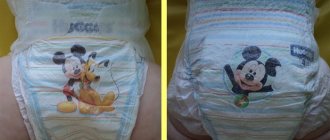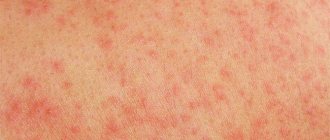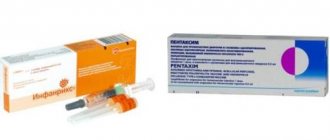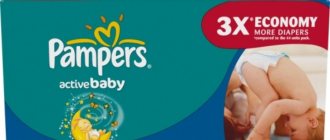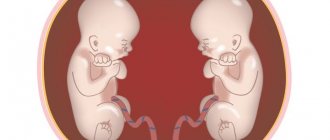The times when children were raised using diapers are long gone. Nowadays, modern parents can enjoy the process of admiring their child, without thinking that after the baby falls asleep, a whole mountain of dirty diapers, blankets, sheets and other things awaits the mother. This is because progress has long presented for public viewing and use a miracle remedy that can easily cope with the as yet unregulated process of urination and defecation in newborns and those who have not yet learned to control this physiological process. We are talking about diapers that are familiar to every person in the world, which for some reason in our country are called diapers by many. Today we would like to clarify one very important question: how are diapers different from diapers? Along the way, we will have to compare the most popular children's accessories among consumers from various manufacturers.
Layers and composition of the diaper
The diaper consists of several layers:
· External waterproofing (waterproof) layer – Back-Sheet – is a thin polyethylene film or non-woven material laminated with a porous polyethylene film. The purpose of this layer is to prevent moisture from leaking out from the absorbent layer.
· Following the plastic film is a chlorine-bleached cellulose cloth that serves as a wrapper for the absorbent powder.
· The main part of the diaper, which allows the skin to remain dry, is a layer of superabsorbent coated with a hydrophilic shell. Hydrophilic means that it attracts water, so all liquid entering the diaper is directed directly into the absorbent layer. Upon contact with urine, the adsorbent absorbs it and swells. The adsorbent is polyacrylate granules. The most commonly used polyacrylate is sodium polyacrylate. In 1985, sodium polyacrylate was banned for use in the production of female tampons due to recorded cases of Toxic Shock Syndrome in women. There is no clinically verified information about how dangerous this substance is when absorbed through the skin of an infant. No research has been conducted on this topic.
· The inner layer in direct contact with the baby's skin - Top-sheet - is made of soft material that allows liquid to pass through only in one direction. Non-woven fabrics made from polypropylene and polyester fibers are used as this layer.
The naked eye can see that the diaper is really plastic baby panties, made from unnatural synthetic materials using an absorbent pad that is very questionable in terms of safety.
Recently, new super-breathable diapers have been actively advertised. According to the advertisement, these diapers “breathe”, that is, they allow air to pass through, which sets them apart from others for the better. However, experts involved in the certification of diapers believe that diapers cannot “breathe” due to the mandatory presence of a polyethylene outer layer.
As Alexander Melnikov, candidate of medical sciences, notes: “Theoretically, it can be assumed that diapers use unusually microscopic perforation, which makes the polymer film “breathable” and at the same time impermeable to moisture. But then this disposable personal care product should cost as much as pure gold jewelry.”
How to choose
Choosing suitable diapers is a very responsible process, so you need to pay attention to the following indicators:
- The inner layer should be soft and delicate, like cotton, because it adheres to sensitive human skin. It should reliably absorb, but not let moisture back through.
- The middle layer of the diaper should instantly conduct and distribute liquid over the entire surface, without accumulating in one place. This is very important, otherwise a lump will form between the legs, which causes a lot of discomfort for the user.
- The elastic band around the legs should be tight and elastic. Its main function is to prevent liquid feces from leaking out, since it is absorbed more slowly than urine.
If you choose this element incorrectly, the following problems may arise: liquid leaking out from the sides, incomplete leg circumference, or strong pinching, which leads to skin irritation.
- The outer layer should be porous, but not permeable to liquid.
- Clasps. They are disposable and reusable. It is better to choose fasteners for repeated use, this will allow you to fasten and unfasten the same diaper several times.
- Size. When choosing this hygiene product, you need to be able to choose the right size so that the product fits tightly around your stomach and does not squeeze anything.
Although children's models indicate the baby's weight, it is worth considering that the proportions of each child are individual. With the same body weight, there can be completely different heights, and, accordingly, the volumes of the abdomen and hips.
Therefore, if the child is overweight, then it is better to choose a slightly larger size, and if the child is thin, then smaller.
When choosing a size for a teenager or an adult, you need to measure your abdomen correctly. It is better to do this using a measuring tape in a lying position along the most protruding areas of the abdomen, and not along the waist line.
When choosing a new brand or purchasing diapers for the first time, you don’t need to buy the largest package. It’s better to take a minimum quantity, and if you like this brand, then buy it for future use.
Half-truth 1. Overheating
Thermal regulation of a child differs from that of an adult. In children it is much less developed. The large surface area of the skin per kilogram of weight, as well as the dense network of skin vessels in infants, contribute to more active heat transfer. When children are overheated, they sweat very little, and they do not experience muscle tremors when they are hypothermic. Thermoregulation is carried out only through chemical mechanisms - accelerating or slowing down the production of internal heat. This imperfection of the heat exchange system leads to the fact that small children can easily freeze in a warm room and quickly overheat at the slightest increase in temperature.
It is important to note that the child will inform the parent about hypothermia by loud crying and active body movements, but if he overheats, he will simply turn red, become lethargic and sleepy.
The diaper covers 30% of the baby's body surface. Since the diaper is made of synthetic material that fits very tightly to the baby’s skin, it acts as a compress, preventing normal air movement, sweating and heat exchange. That is, the breathing of the skin is, to a greater or lesser extent, impaired in this area of the skin. As a result of the evaporation of urine inside the diaper, a slight greenhouse effect occurs. The temperature in the diaper rises by 0.1-0.5°C, and the child’s body rises accordingly to 36.7-37°C.
Common sense on the part of parents in this case should be manifested in the fact that the child should be left at home without a diaper more often, so as not to artificially provoke overheating, even if local and insignificant.
Additional factors
To ensure that diapers leak less and do not cause discomfort, manufacturers are constantly optimizing models. Some improvements are very useful. Among them:
- External indication.
A wetness indicator is applied to the outside: if the scale or sign changes color, it’s time to change the diaper. In Abena, for example, the indicator is segmented and shows the degree of occupancy - from minimal to high. In Molicare, the indicator is printed in the form of blue stripes; it disappears only when the diaper is maximally full.
- Elastic waistband.
On waist and classic models, the waistband is made stretchable by inserting stretchable cuffs into it. This way the diaper fits more firmly to the body, which is very important for overweight people. Models with a soft belt are available from Molicare, Abena, Tena.
- Hypoallergenic composition.
Thus, manufacturers claim that the materials from which the diaper is made are suitable for people with delicate skin. But there are patients with extremely sensitive skin, and in fact it may turn out that an allergy will manifest itself to the gentle composition.
- Breathable composition that absorbs unpleasant odors.
The designation "breathable" means that the material moves air away from the body. But here's the thing: if the air comes out, the bad smell comes out with it. To prevent this from happening, you need a powerful absorbent, or superabsorbent. It instantly absorbs liquid and, swelling, becomes gel-like. This blocks the smell.
Practice shows that breathable materials are more comfortable to use, but they are also more expensive. And vice versa: models with low performance characteristics are usually made using cheap materials (for example, polyethylene compounds), so they rustle unpleasantly and create a greenhouse effect underneath.
- Sides or cuffs to protect against leakage.
This is a useful advantage of classic diapers, panties and waist models: only in them can you add internal bumpers that will hold the contents of the diaper inside. This additional protection against leaks is found in all brands.
- Reusable fasteners.
Useful if you need to take off and put on a diaper several times (for example, during procedures). Otherwise, you will need a new product for each change. Therefore, diapers with disposable fasteners are cheaper (for example, Super Seni), and they are often provided free of charge under an individual rehabilitation program.
More expensive models are equipped with reusable fasteners: for example, Molicare diapers (manufactured by Hartmann) and all Abena models have them.
Half-truth 2. Harm to boys
The question of the negative impact of increased temperature and humidity in a diaper on spermatogenesis and male reproductive function remains very controversial. Proponents of this theory argue that as a result of the greenhouse effect, irreversible changes occur in testicular tissue, leading in the future to infertility and decreased potency. However, these statements have no scientific evidence and are still only assumptions.
German endocrinologists in 1997 measured the temperature of the scrotal skin in boys under 1 year old who used cotton and disposable diapers. When using cotton diapers, the scrotal skin temperature was 34.9°C, and when using disposable ones – 36°C. When using diapers, the temperature of the scrotal skin increased by 1.1°C. But such an increase in the temperature of the skin of the scrotum does not have a negative effect on the testicular tissue, since the adaptive properties of thermoregulation help maintain a constant temperature inside the scrotum.
To better understand the processes occurring in the testicle in young boys, it is necessary to touch upon the structure and physiology of the testicle. The fetal testicle is laid in the abdominal cavity and descends into the scrotum by the time of birth. In a newborn, the seminiferous tubules look like solid cellular cords without a lumen. Clearance in the seminiferous tubules appears only at 7-8 years of age. At this time, single spermatocytes appear. And only by the age of 10-15 the first sperm appear. Spermatogenesis in boys begins no earlier than 7 years of age, and, therefore, in infants there can be no talk of the process of its suppression. In the first years of life, the hormonal activity of Leydig cells, which produce male sex hormones - testosterone and androgens - is also minimal.
As early as 1968, urologist Taylor Robinson studied the effects of high temperatures on spermatogenesis in adult men by immersing the scrotum in warm water. Inhibition of spermatogenesis occurred only when the water temperature increased to 45°C with a duration of exposure of at least 30 minutes for 14 days.
However, there is one interesting fact that allows you to look at this issue from a completely different angle. In England, more than a hundred years ago, “diapers” were used by sheep farmers to sterilize rams. They put warm fur bags over the testicles of the ram and dried them instead of painful castration. Worth thinking...
The above facts indicate a divergence of opinion on the issue of the harmful effects of diapers on the reproductive health of boys. However, consciously denying the fact that, according to male anatomy, it is desirable for boys’ genitals not to overheat, is simply unreasonable and even stupid. Therefore, the parent's common sense here should be to use a diaper for a baby boy as little as possible and try to ventilate and keep the baby cool as often as possible.
Half-truth 3. Harm to girls
In girls, the genitals are more accessible to infections. For this reason, in modern medicine, the use of diapers is often associated with early vaginitis, thrush, fusion of the labia minora, cystitis and disorders of the genitourinary system. Indeed, the plastic membrane in the diaper creates ideal conditions for the development of anaerobic bacteria, in particular those that are excreted in the feces and then remain for several hours in a warm, humid, unventilated environment, thereby provoking the development of infections.
But it is not the diapers themselves that harm girls’ health, but their untimely replacement, lack of hygiene and improper care. Therefore, it is not worth loudly declaring the dangers of diapers for the health of girls, because this issue still remains open and clinically unstudied.
Half-truth 4. Dermatitis
Another controversial point is that diapers are blamed for the appearance of diaper dermatitis, which causes redness, irritation and diaper rash on the skin. Diaper dermatitis is caused by ammonia in the urine affecting the baby's skin. It occurs when uric acid combines with feces. In the diaper, urine does not go anywhere for a long time, it is simply absorbed by the adsorbent, so of course the risk of dermatitis increases severalfold .
To this are often added allergic reactions to creams and lotions, which are added by manufacturers for additional care of the child’s skin.
But if you change diapers on time, wash your baby more often, give him air baths, lubricate the folds on the body, then allergic reactions on the skin and dermatitis often do not affect the child.
The best diapers for newborns 2019
Over the years of use, parents have left many reviews for companies that produce diapers. Based on them, a rating of the best was compiled. This allows new parents to compare options and choose the most suitable one.
Hypoallergenic
Huggis diapers rank first in safety. They are in great demand among parents. One of the important advantages is hypoallergenicity. They do not contain flavorings or fragrances, which is so important for a young body that has not yet had time to get stronger.
With moisture indicator
A special development helps parents know when the diaper is full. This can be a regular strip of bright color. Some diaper manufacturers put a whole pattern on their products, which disappears when the hygiene product is full.
For swimming in the pool
The Libero brand stands out for its original line of diapers, which are made for water bathing. No cellulose or sorbents are used in production. Therefore, they perform their functions perfectly and do not swell in water.
For boys and girls
Pampers has a line that includes models for girls and boys. Thanks to the mesh layer, absorption occurs faster. The material does not rub the skin, eliminating the possibility of diaper rash and other skin problems.
To potty train a child
The Japanese brand Muni produces special training panties and diapers. With their help, they teach the baby to potty. The absorbent layer continues to remain wet. The baby feels this and is uncomfortable. Thus, the understanding comes that you need to ask to go to the potty.
For low birth weight and premature babies
Usually this is a size range of 0 - for premature babies and 1-2 for full-term babies. Some manufacturers do not produce diapers in such small sizes. The leaders are Pampers and the Japanese brand Goo.N. Tiny and made of lightweight material. They contain aloe extract to make the child feel as comfortable as possible.
To choose a diaper for your baby, you need to start from the characteristics of the body. Parents should not choose the company that comes first in the top. If a certain type of diaper fits one child, it is not a fact that it will fit well on the body of another child. In this regard, you need to carefully approach the choice.
Diapers and the mental development of the child
The development of a child occurs strictly according to the laws established by nature, regardless of whether we know them or not, accept or reject them. Human intellectual development is not just the accumulation of knowledge, but the ability to establish cause-and-effect relationships. This skill, as the foundation of a future personality, is laid in the first year of life. It is in infancy that the foundations of worldview are formed: the baby makes his first intellectual discoveries in diapers. The child needs a lot of mental work to establish the first cause-and-effect relationships in life between the urge to urinate and defecate and their result.
Disposable diapers deprive the baby of this first “scientific” discovery, slowing down the initial natural impulse to the development of intelligence. A child experiences the world with his body. His thinking is based on tactile contacts. If you deprive a baby of the sensations he needs, there is no point in further talking about the development of intelligence. For timely and harmonious development, the baby must come into contact with mom and dad, touch various textures - sand, water, fabrics, stones, blades of grass, trees, and must explore his own body - from touching to the sensations that arise during urination and defecation.
This does not mean at all that the child should lie in his own waste and mess around in it. This means that he must feel them and must understand what sensations, emotions and actions will follow them. Diapers prevent him from experiencing this.
The influence of diapers on mental development does not end in the first year of life. Deprived of natural tactile sensations, a child may lose interest in kinesthetic exploration. This is how squeamish one-year-old and two-year-old neat kids appear, afraid to get their hands dirty and touch unknown objects - and this is a disaster for the development of the child’s intellect and psyche, which by their nature should be aimed at everyday knowledge and awareness of the surrounding reality.
Characteristics
Dimensions
Children's
Each manufacturer of baby diapers indicates the size on the packaging based on the child’s weight. Trademarks have individual ratios of size tables; below are the average values:
- Size No. 1 is intended for children weighing up to 5 kg - this category includes babies up to two months.
- No. 2, weight 3-7 kg – up to 4 months.
- No. 3, 4-9 kg – from 3 to 12 months.
- No. 4, 10-18 kg – from 7 to 18 months.
- No. 5, 12-20 kg – from one to two years.
- No. 6, 15-25 kg – from one and a half years.
Absorbent underwear in size 1 has a cutout on the top edge so that the diaper strap does not irritate the umbilical wound in newborns. Many manufacturers have created models for premature babies weighing up to 3 kg - as a rule, this is size No. 0.
For adults and teenagers
The size range of adult and teenage models depends on waist size:
- XS – 40-60 cm;
- S – 50-70 cm;
- M – 60-100 cm;
- L – 90-120 cm;
- XL – 100-130 cm;
- XXL – 120-150 cm.
For the convenience of users, each manufacturer produces packages with different numbers of diapers (from 10 to 150 pcs.).
Reusable diapers
The size of disposable diapers is always standard:
- 40x60 cm;
- 60x60 cm;
- 60x90 cm.
Absorbency
Children's
The degree of absorption of diapers depends on the size range: the higher the size of the diaper, the more liquid it absorbs:
- Linen up to 5 kg absorbs 515-625 ml;
- 4-9 kg – 787 ml;
- 10-18 kg – 931-1005 ml;
- 12-20 kg – 1068 ml;
- 15-25 kg – up to 1500 ml.
Teens and adults
On packaging for adults and teenagers, the level of absorption is indicated in milliliters or the number of “droplets”. Adult diapers absorb from 750 ml to 3 liters of moisture.
Each manufacturer has its own ratio of “droplets” to milliliters, but in most cases there is a summary table on the packaging, thanks to which you can easily determine the amount of liquid absorbed.
Absorption rate according to size:
- XS and S – 800-1800 ml;
- M – 1000-3600 ml;
- L – 1100-4100 ml;
- XL – 1500-3300 ml.
Diapers
The absorbency of disposable absorbent diapers depends on the size:
- 40×60 cm – 250-750 ml;
- 60×60 cm – 350-2100 ml;
- 90×60 cm – 650-1550 ml.
Diapers and the world around us
Education as an environmentalist does not allow me to remain silent about the consequences of using diapers on a global scale. I had to visit both treatment plants and solid waste landfills. There is polyethylene everywhere. Plastic containers, bags, cans, bottles, pads, boxes, packaging and, of course, diapers.
If a child grew up on disposable diapers, then his parents’ contribution to environmental pollution was 2.5 tons. If you only used diapers for up to a year, then “only” 1 ton. Due to its synthetic composition, a diaper takes about 500 years to decompose in the ground. The thick plastic garbage bag in which we wrap this diaper for convenience will decompose in 1000 years. A worthy legacy of our civilization to our descendants. Worthy collective karma, to say the least...
Well-known pediatrician Evgeniy Komarovsky said on this occasion: “Disposable diapers, like household waste that can cause significant harm to the environment, are one of the most real and most tangible problems. And this problem is especially relevant in our country, where waste recycling technology leaves much to be desired, to put it mildly. All serious manufacturers claim that the materials are biodegradable, and if not, then they are inert and not capable of poisoning the environment, but this does not make it any easier.”
Our recommendations
Our advice is simple: be careful with your child.
While it can be difficult to know exactly how chemicals from disposable diapers may affect your baby, or the extent of your risk of exposure, we think it's better to be safe than sorry.
Based on the research compiled above, we recommend that you choose a diaper with the following characteristics:
- Chlorine-free
- No fragrance
- Preferably phthalate free
- No dyes
- None of the diapers we tested were perfect, but there's nothing super dangerous about them.
